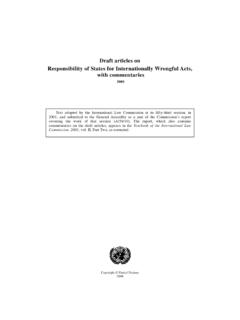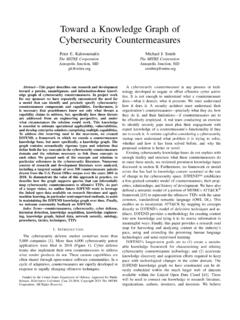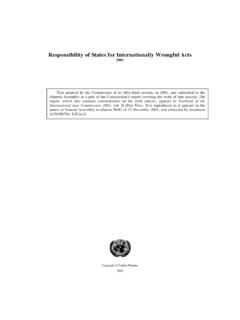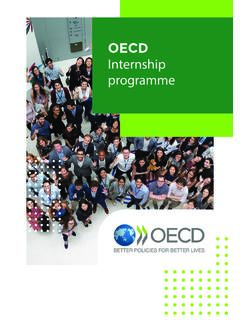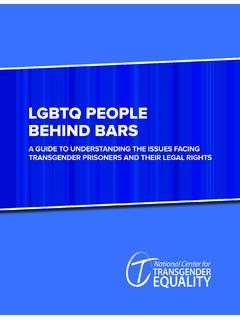Transcription of Guidance for Tax Administrations on the Application of the ...
1 Guidance for Tax Administrations on the Application of the Approach to hard -to- value intangibles INCLUSIVE FRAMEWORK ON BEPS: ACTION 8 June 2018 Guidance FOR TAX Administrations ON THE Application OF THE APPROACH TO hard -TO- value intangibles , OECD 2018 Guidance FOR TAX Administrations ON THE Application OF THE APPROACH TO hard -TO- value intangibles , OECD 2018 This document and any map included herein are without prejudice to the status of or sovereignty over any territory, to the delimitation of international frontiers and boundaries and to the name of any territory, city or area.
2 Please cite this document as: OECD (2018), Guidance for Tax Administrations on the Application of the Approach to hard -to- value intangibles - BEPS Actions 8-10, OECD/G20 Base Erosion and Profit Shifting Project, OECD, Paris. OECD 2018 You can copy, download or print OECD content for your own use, and you can include excerpts from OECD publications, databases and multimedia products in your own documents, presentations, blogs, websites and teaching materials, provided that suitable acknowledgment of the source and copyright owner is given. All requests for public or commercial use and translation rights should be submitted to Requests for permission to photocopy portions of this material for public or commercial use shall be addressed directly to the Copyright Clearance Center (CCC) at or the Centre fran ais d'exploitation du droit de copie (CFC)
3 At 3 Guidance FOR TAX Administrations ON THE Application OF THE APPROACH TO hard -TO- value intangibles , OECD 2018 Foreword The integration of national economies and markets has increased substantially in recent years, putting a strain on the international tax rules, which were designed more than a century ago. Weaknesses in the current rules create opportunities for base erosion and profit shifting (BEPS), requiring bold moves by policy makers to restore confidence in the system and ensure that profits are taxed where economic activities take place and value is created.
4 Following the release of the report Addressing Base Erosion and Profit Shifting in February 2013, OECD and G20 countries adopted a 15-point Action Plan to address BEPS in September 2013. The Action Plan identified 15 actions along three key pillars: introducing coherence in the domestic rules that affect cross-border activities, reinforcing substance requirements in the existing international standards, and improving transparency as well as certainty. After two years of work , measures in response to the 15 actions were delivered to G20 Leaders in Antalya in November 2015.
5 All the different outputs, including those delivered in an interim form in 2014, were consolidated into a comprehensive package. The BEPS package of measures represents the first substantial renovation of the international tax rules in almost a century. Once the new measures become applicable, it is expected that profits will be reported where the economic activities that generate them are carried out and where value is created. BEPS planning strategies that rely on outdated rules or on poorly co-ordinated domestic measures will be rendered ineffective. Implementation is now the focus of this work .
6 The BEPS package is designed to be implemented via changes in domestic law and practices, and in tax treaties. With the negotiation for a multilateral instrument (MLI) having been finalised in 2016 to facilitate the implementation of the treaty related measures, over 75 jurisdictions are covered by the MLI. The entry into force of the MLI on 1 July 2018 paves the way for swift implementation of the treaty related measures. OECD and G20 countries also agreed to continue to work together to ensure a consistent and co-ordinated implementation of the BEPS recommendations and to make the project more inclusive.
7 Globalisation requires that global solutions and a global dialogue be established which go beyond OECD and G20 countries. A better understanding of how the BEPS recommendations are implemented in practice could reduce misunderstandings and disputes between governments. Greater focus on implementation and tax administration should therefore be mutually beneficial to governments and business. Proposed improvements to data and analysis will help support ongoing evaluation of the quantitative impact of BEPS, as well as evaluating the impact of the countermeasures developed under the BEPS Project.
8 As a result, the OECD established an Inclusive Framework on BEPS, bringing all interested and committed countries and jurisdictions on an equal footing in the Committee on Fiscal Affairs and all its subsidiary bodies. The Inclusive Framework, which already has more than 110 members, is monitoring and peer reviewing the implementation of the minimum standards as well as completing the work on standard setting to address BEPS issues. In 4 Guidance FOR TAX Administrations ON THE Application OF THE APPROACH TO hard -TO- value intangibles , OECD 2018 addition to BEPS members, other international organisations and regional tax bodies are involved in the work of the Inclusive Framework, which also consults business and the civil society on its different work streams.
9 This report was approved by the Inclusive Framework on BEPS on 4 June 2018 and prepared for publication by the OECD Secretariat. 5 Guidance FOR TAX Administrations ON THE Application OF THE APPROACH TO hard -TO- value intangibles , OECD 2018 Table of contents Foreword .. 3 Abbreviations and acronyms .. 7 Executive summary .. 9 1. Introduction .. 11 2. Examples .. 14 3. Dispute prevention and resolution in relation to the HTVI approach .. 17 7 Guidance FOR TAX Administrations ON THE Application OF THE APPROACH TO hard -TO- value intangibles , OECD 2018 Abbreviations and acronyms APA Advance pricing arrangement BEPS Base erosion and profit shifting G20 Group of twenty HTVI hard -to- value intangible MLI Multilateral Convention to Implement Tax Treaty Related Measures to Prevent BEPS OECD Organisation for Economic Co-operation and Development TP Transfer pricing 9 Guidance FOR TAX Administrations ON THE Application OF THE APPROACH TO hard -TO- value intangibles .
10 OECD 2018 Executive summary Action 8 of the Action Plan on Base Erosion and Profit Shifting mandated the development of transfer pricing rules or special measures for transfers of hard -to- value intangibles (HTVI) aimed at preventing base erosion and profit shifting by moving intangibles among group members. The outcome of that work is the approach to hard -to- value intangibles , which is found in the 2015 Final Report for Actions 8-10, "Aligning Transfer Pricing Outcomes with value Creation" (BEPS TP Report) and it was formally incorporated into the Transfer Pricing Guidelines, as Section of Chapter VI.











